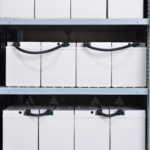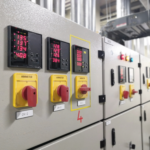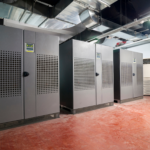[bra_blockquote align=”right”]
Lead acid batteries are designed to deliver a maximum number of discharge/recharge cycles before reaching end of life at which point the battery must be replaced.
[/bra_blockquote][bra_dropcaps style=”dropcap1″]B[/bra_dropcaps]atteries have a limited service life, usually showing a slow decline in capacity until they reach approximately 80 percent of their original rated capacity, which is followed by a fairly rapid decline. There are five primary factors that affect UPS battery life: ambient temperature, cycling, battery chemistry, application and maintenance.
1. Ambient Temperature
The rated capacity of a battery is based on an ambient operating temperature of 25°C (77°F). Any variation from this operating temperature can alter the performance of the battery and shorten its expected life.
For example, as a general rule, remember that for every 8.3°C (15°F) average annual temperature above 25°C (77°F), the life of the battery is reduced by 50 percent.
2. Cycling
During a power failure, a UPS operates on battery power. Once utility power is restored, or a switch to generator power is complete, the battery is recharged for future use. This is called
a discharge cycle. At installation, the battery is at 100 percent of rated capacity. Each discharge and subsequent recharge cycle reduces the relative capacity of the battery by a small percentage. The reduction in battery capacity is based on the length and depth of the discharge cycle.
Lead acid batteries are designed to deliver a maximum number of discharge/recharge cycles before reaching end of life at which point the battery must be replaced.
3. Battery Chemistry
Because of the chemical composition of batteries, their ability to store and deliver power slowly decreases over time. Even if you follow all the guidelines for proper storage temperature and maintenance, you still must replace them after a certain period of time.
4. Application
It’s imperative that the right battery be used for the given application. Problems arise if the wrong battery is used. For example – UPS batteries such as the EnerSys HX line and C&D Technologies MR line are rated in Watts-Per-Cell and have the ability to deliver very high rates for a short period of time, generally 15-minutes to an end cell of 1.67vpc. On the other hand, telecom and switch-gear batteries are rated in Ampere-Hours and are designed to run for longer periods of time, typically 4-8 hours. If a UPS battery is used in a telecom application the user will likely try to run the battery for far longer than a UPS battery is meant to run. UPS Batteries are designed with a greater number of thin plates in order to achieve the high rate discharge. Discharging a UPS battery for hours will cause the plates to overheat and deflect. When the battery cools it creates stresses on the internal lead strap which holds the plates together. Over time this will cause the battery to fail prematurely.
Rule of Thumb: High Rate = Short Discharge, Low Rate = Long Discharge
EnerSys and C&D Technologies manufacture telecom, switchgear and UPS batteries – make sure you have the correct battery in place for your needs to avoid unnecessary downtime.
5. Maintenance
Service and maintenance of batteries are critical to the reliability of the UPS. A gradual decrease in battery life can be monitored and evaluated through voltage and impedance checks, load testing or battery monitoring systems. Periodic preventive maintenance can help extend the life and prevent the loss of capacity in a battery by preventing loose connections, removing corrosion and identifying bad batteries before they can affect the rest of the string. Even though sealed batteries are sometimes referred to as maintenance-free, EnerSys and other battery manufacturers still require scheduled maintenance and service. Maintenance-free simply refers to the fact that they do not require watering.
Without regular maintenance, your UPS battery may experience heat-generating resistance at the terminals, improper loading, reduced protection and premature failure. With proper maintenance, the end of battery life can be accurately estimated and replacements scheduled without unexpected downtime or loss of backup power.





